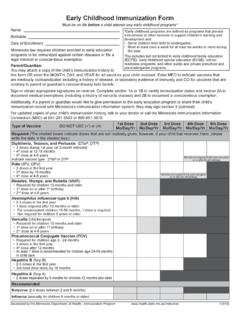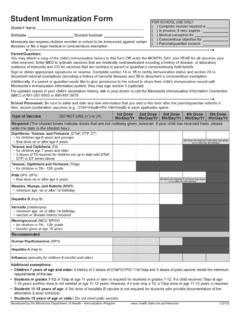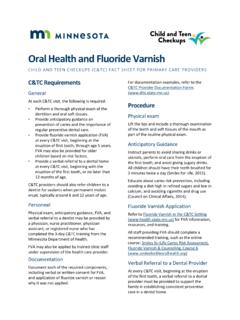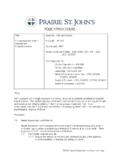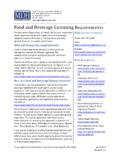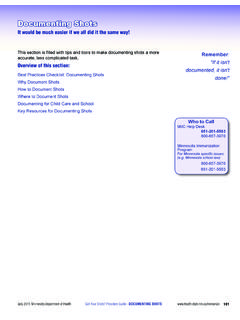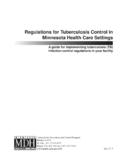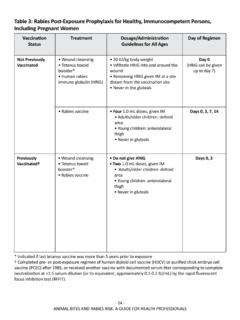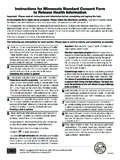Transcription of TESTING, INSPECTION AND MAINTENANCE OF FIRE ALARM …
1 INSPECTION AND TESTING OF FIRE ALARM SYSTEMS Introduction Early warning plays a key role in a health care facility s ability to safely evacuate its residents during a fire emergency. As a result, a lot is riding on your fire ALARM system s ability to operate and function properly. So much so, in fact, that state law prohibits the occupancy of any portion of a building until the required fire ALARM and detection system has been tested and approved see MSFC(15), Sec. Further, MSFC(15), Sec. requires that such systems be maintained in an operative condition at all times and be repaired or replaced when defective. In order to meet both federal certification requirements and state licensure requirements, fire ALARM systems are required to be inspected, tested and maintained in accordance with NFPA 72, National Fire ALARM Code.
2 For federal certification, NFPA 101(12), Sec. references the 2010 edition of NFPA 72. For state licensure, MSFC(15), Sec. , as amended, and Table , also reference the 2010 edition of NFPA 72 (see Chapter 80, Referenced Standards). Note: In accordance with MSFC(15), Sec. , nonrequired fire protection systems and equipment must also be inspected, tested and maintained or be removed. A similar requirement can be found in NFPA 101(12), Sec. Application It must be noted that this document is intended to serve as a quick-reference guide only and is not intended to be exhaustive. It covers most, but not all, of the INSPECTION , testing and MAINTENANCE requirements applicable to fire ALARM systems. Some facilities may have additional equipment not covered in this guide. It is important, therefore, that the user have access to, and become familiar with all the requirements found in, NFPA 72.
3 The standard can be ordered from NFPA at 1-800-344-3555 or NFPA Catalog ( ). Definitions In order to follow the requirements of NFPA 72, it is helpful to have a good understanding of what is meant by INSPECTION , testing and MAINTENANCE . While the terms INSPECTION and testing are not separately defined in the standard, the definitions of INSPECTION personnel and testing personnel serve as a good indicator of what is meant by the use of the two terms: o NFPA 72(10), Sec. defines INSPECTION personnel as, Individuals who conduct a visual examination of a system or portion thereof to verify that it appears to be in operating condition, in proper location, and is free of physical damage or conditions that impair operation. o NFPA 72(10), Sec. defines testing personnel as, Individuals who perform procedures used to determine the status of a system as intended by conducting acceptance, reacceptance, or periodic physical checks on systems.
4 NFPA 72(10), Sec. defines MAINTENANCE as, Work including, but not limited to, repair, replacement, and service, performed to ensure that equipment operates properly. Personnel qualifications It is the facility s responsibility to ensure that only properly trained and competent persons perform inspections, testing and MAINTENANCE on its fire ALARM system [see NFPA 72(10), ]. Typically, facility personnel are limited to performing INSPECTION and some basic testing activities only. The amount of testing that can be performed will depend on the level of training received. One of the best sources for such training would be the Page 2 of 8 June, 2016 fire ALARM contractor that performs the facility s annual service. Evidence of any training received will need to be maintained in each employee s personnel file. System history A number of requirements applied to a health care facility s fire protection systems are based on the age and date of installation of those systems.
5 Without an accurate written history of the fire protection system(s) in your facility, it can be difficult to prove to a state or federal life safety surveyor that those systems are being maintained in accordance with applicable state and federal standards. This can result in fire/life safety deficiencies being cited. Turnover of administrative and/or MAINTENANCE personnel only serves to compound the problem. Many authorities having jurisdiction (AHJs) require that a record of completion form be provided before they will give final approval of the initial installation or subsequent modification of a fire ALARM system. o NFPA 72(10), Sec. requires that one copy of the record of completion be stored at the fire ALARM control unit or other approved location. o All system modifications made after the initial installation are expected to be recorded on a revised version of the original record of completion, which is expected to be maintained current at all times see NFPA 72(10), Sections and o If not kept at the main fire ALARM control unit, the location of these documents must be identified at the main fire ALARM control unit see NFPA 72(10), Sec.
6 The enclosure or cabinet in which the documents are stored must be prominently labeled FIRE ALARM DOCUMENTS see NFPA 72(10), Sec. Note: A sample record of completion form is provided in NFPA 72 see Figure An example of a filled out record of completion form can be found in Annex A see Figure Unfortunately, not all systems have a record of completion, or the document may have gotten lost over the years. If such is the case at your facility, it is recommended that you create and maintain your own historical record on your system(s). As with just about anything, the hardest part of creating an historical record is getting started after that, it s a matter of keeping it up-to-date. You should find the fire ALARM contractor that provides your annual service to be an excellent source of information about your system.
7 Basic questions that need to be answered include: o When was the system initially installed? Who installed it? o Were any additions, modifications or repairs made to the system? When? Who did the work? o What means of communication is used to transmit a fire ALARM signal between your facility and the supervising station ( DACT)? o What type of batteries, if any, serve as a secondary power supply for the fire ALARM system? It is important to note that certain changes made to your building could necessitate changes or additions to your fire ALARM system. Things to watch for include construction or removal of walls, change in use of an area, installation or removal of fire sprinkler protection, and the installation of egress door locking arrangements. Specific Requirements The INSPECTION , testing and MAINTENANCE requirements that apply to your building s fire ALARM system start from the date of initial installation and continue on at specific intervals throughout the life of the system.
8 What follows is a brief synopsis of some of the major requirements you need to be aware of. Page 3 of 8 June, 2016 New installations In order to meet both federal certification requirements and state licensure requirements, fire ALARM systems are required to be installed in accordance with NFPA 72 and the requirements of the Minnesota State Fire Code (MSFC) and NFPA 101 applicable to I-2 or healthcare occupancies [see MSFC(15), Sections and ; NFPA 101(12), Sections and ]. All newly installed systems are required to be acceptance tested in accordance with the requirements of Chapter 14 of NFPA 72(10). MSFC(15), Sec. requires that the fire code official be notified prior to such testing. Notifications In order to avoid unnecessary occupant response and potential injury to emergency response personnel, it is very important that all affected parties be notified prior to any scheduled testing of the fire ALARM system [see NFPA 72(10), Sec.]
9 ]. Those notified should include, but not be limited to, building occupants ( visitors, staff and patients/residents) and the monitoring company or agency. System modifications 1. Reacceptance testing is required after any of the following occur [see NFPA 72(10), Sec. ]: o Addition or deletion of system components o Any modification, repair or adjustment to system hardware or wiring o Any change to site-specific software 2. Again, MSFC(15), Sec. requires that the fire code official be notified prior to such testing. 3. The extent of testing necessary is determined as follows see NFPA 72(10), Sec. : o When an initiating device, notification appliance or control relay is added, it must be functionally tested. o When an initiating device, notification appliance or control relay is deleted, another device, appliance or control relay on the circuit must be operated.
10 O When modifications to control equipment hardware are made, the control equipment must be tested in accordance with Table , items 1(a) and 1(d). o When changes are made to site-specific software, all functions known to be affected by the change, or identified by a means that indicates changes, must be 100 percent tested. In addition, 10 percent of initiating devices that are not directly affected, up to a maximum of 50 devices, must also be tested and proper operation verified. o Whenever there are changes to control units connected or controlled by the system executive software, a 10 percent functional test of the system is required, including a test of at least one device on each input and output circuit to verify critical system functions such as notification appliances, control functions and off-premises reporting. Semiannually 1.

